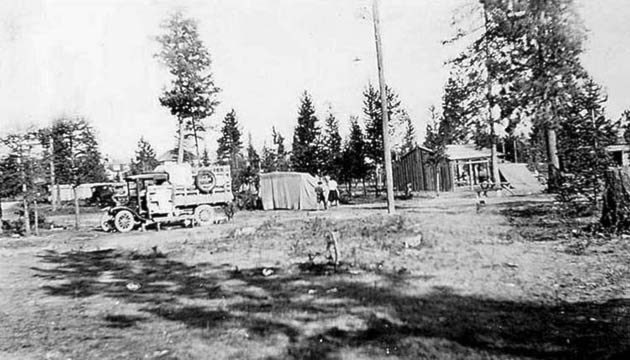JIM CAMERON
In the spring of 1912 there were 45 automobiles in the city of Cranbrook. By 1925, the number had grown to 1100 and was steadily increasing.
The roads varied from rugged to practically nonexistent. People were more joltingly mobile than any time in history and for those counting cars, the increasing traffic humming through the city became “tourists.” Vacationers had money and were willing to spend it.
They required gasoline, auto parts, servicing, groceries, dry goods, and, perhaps most importantly, a safe, reasonably-priced place to spend the night, all facts that were not lost on the Cranbrook Board of Trade of the day.
In July, 1920, both the board and the city combined to provide funding for a small wooden tourist park shelter to be constructed near the old rink on Norbury Avenue. At the time the rink and the city garage sat on the northern end of the generally marshy area that would, in a few years, become Rotary Park.
It was a good location for a tourist park: city-owned land with a small creek running through and the Hanson Garage across the street, near to the business section with water and light hookup and the adjoining rink for shelter if required.
The local prophets of tourism predicted popularity with auto travelers and they were soon proved correct. By the following year the camp was in constant use, with vehicles from across North America registered nightly. Jake Smith, a local entrepreneur, set up a collection of side shows and children’s rides near the site to entertain campers who were allowed to camp free of charge for the first week and pay a nominal sum for each additional night.
August, 1922, saw 122 cars register, up from 108 the previous year. On one particular night a vehicle carrying a number of singing canaries, a car with two elderly ladies and half a dozen cats, a pointer canine and a tame bear all took their place in the campground with no fuss whatsoever.
It was so popular, in fact, that it was rapidly becoming inadequate to the demand and, in 1923, the Board of Trade proposed a site at the extreme end of Pooley (13th) Avenue. The spot was “park-like”: a large field at the foot of a sloping hillside with evergreen trees for cover shading the clear, meandering waters of Joseph Creek and with easy access to water, light and sewer connections and room for at least 60 cars per night.
The land belonged to the Canadian Pacific Railway (they owned a sizable share of the city land at the time) but the city brokered an agreement for ownership of the property. By 1924, the original auto camp was greatly overtaxed with the arrival of 30–50 vehicles nightly and so, on Thursday, July 16, 1925, the new Cranbrook Municipal Auto Camp officially opened in its present day location along 2nd Street to the east of 14th Avenue, featuring a cookhouse with 4 stoves, an office and a wash-house complete with a cold “shower-bath” (hot water arrived the following year).
Although some had argued its location would make it difficult for travelers to find as it was, after all, five blocks away from the main road, it was an immediate success and all fears were laid to rest as business quickly boomed. People and vehicles of all description could be seen on any given night; license plates from around the continent.
The rates were reasonable, the people friendly and the entire park neat and tidy. Large automobile clubs passed through regularly as the popularity of the “Red Trail” (B.C.’s most southerly route) grew. Ten bungalows were built in 1930, constructed from lumber salvaged from the demolition of the old Cranbrook Fire Hall next to city hall on Norbury Avenue.
The Gyro club erected the ‘largest outdoor pool in Western Canada’ right next door the same year, which entertained hundreds daily for free. Trees and flowers were planted and facilities improved yearly. From May to September the Tourist Camp was proving to be a wise investment indeed. In 1929, nearly 20,000 vehicles crossed the U.S. border at Kingsgate, 2000 of which stayed at the Park that season.
Despite the growing economic depression of the 1930s, the park saw ever-increasing numbers with the city constructing an adjacent softball field, three tennis courts, a large playground and eight additional bungalows.
In 1945, the Vancouver Province newspaper stated that Cranbrook was a “…city of attractive stores, beautiful homes and friendly people” and boasted a tourist camp that could “compare with any civic enterprise of its kind in B.C.” Cranbrook billed it simply as “the finest in Western Canada.”
A Calgary newspaper article back in 1923 mentioned “something unusual recently arrived in Calgary…on the back of a Ford car a small shack has been built to provide proper accommodation for the travelers.” It was a concept that caught on rapidly as campers and trailers gradually became the norm.
By 1960, there were so many self-contained tourists that the park bungalows were removed in favour of trailer pads with sewage and electrical hook-ups. Sadly, the swimming pool was shut down in the 1960’s and recently much of the adjoining Baker Park green space was obliterated by a city housing project but the present-day Mt. Baker RV Park still remains as popular as ever.
Perhaps silver-screen movie legend Joan Crawford said it best during a trip through Cranbrook in June, 1950. Asked how she and her dog “Poochie” enjoyed their stay in the park she replied, “This is truly an ideal spot.” A fact that has remained true for over 90 years.
